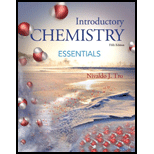
Concept explainers
Interpretation:
In nuclear series of equations of
Concept Introduction: The equations representing the changes that take place during radioactivity and other nuclear processes are called
The nuclear equation should be balanced just like the chemical equations.
In a balanced nuclear equation, the sum of the
The atom undergoing nuclear disintegration is called parent nuclide and the products obtained are called daughter nuclide.
The bombardment of a neutron on the nucleus increases the mass number by unit one.
The identity and symbol of the daughter nuclide formed by an alpha decay can be deduced from the
In an alpha decay, nucleus emits a particle with mass number 4 and atomic number 2 which is equivalent to a helium nucleus. Thus, in an alpha decay, the mass number decreases by 4 and the atomic number decreases by 2. In a beta decay, the nucleus emits an electron. During a beta decay, the mass number remains the same as an electron has no protons or neutrons but atomic number increases by 1 as electron carries one unit of negative charge.
The symbols of the neutron, an alpha particle, and beta particle are
Want to see the full answer?
Check out a sample textbook solution
Chapter 17 Solutions
Introductory Chemistry Essentials Plus MasteringChemistry with eText -- Access Card Package (5th Edition)
 General Chemistry - Standalone book (MindTap Cour...ChemistryISBN:9781305580343Author:Steven D. Gammon, Ebbing, Darrell Ebbing, Steven D., Darrell; Gammon, Darrell Ebbing; Steven D. Gammon, Darrell D.; Gammon, Ebbing; Steven D. Gammon; DarrellPublisher:Cengage Learning
General Chemistry - Standalone book (MindTap Cour...ChemistryISBN:9781305580343Author:Steven D. Gammon, Ebbing, Darrell Ebbing, Steven D., Darrell; Gammon, Darrell Ebbing; Steven D. Gammon, Darrell D.; Gammon, Ebbing; Steven D. Gammon; DarrellPublisher:Cengage Learning Chemistry & Chemical ReactivityChemistryISBN:9781337399074Author:John C. Kotz, Paul M. Treichel, John Townsend, David TreichelPublisher:Cengage Learning
Chemistry & Chemical ReactivityChemistryISBN:9781337399074Author:John C. Kotz, Paul M. Treichel, John Townsend, David TreichelPublisher:Cengage Learning Chemistry: The Molecular ScienceChemistryISBN:9781285199047Author:John W. Moore, Conrad L. StanitskiPublisher:Cengage Learning
Chemistry: The Molecular ScienceChemistryISBN:9781285199047Author:John W. Moore, Conrad L. StanitskiPublisher:Cengage Learning- Chemistry: Matter and ChangeChemistryISBN:9780078746376Author:Dinah Zike, Laurel Dingrando, Nicholas Hainen, Cheryl WistromPublisher:Glencoe/McGraw-Hill School Pub Co
 Chemistry: Principles and ReactionsChemistryISBN:9781305079373Author:William L. Masterton, Cecile N. HurleyPublisher:Cengage Learning
Chemistry: Principles and ReactionsChemistryISBN:9781305079373Author:William L. Masterton, Cecile N. HurleyPublisher:Cengage Learning General, Organic, and Biological ChemistryChemistryISBN:9781285853918Author:H. Stephen StokerPublisher:Cengage Learning
General, Organic, and Biological ChemistryChemistryISBN:9781285853918Author:H. Stephen StokerPublisher:Cengage Learning





